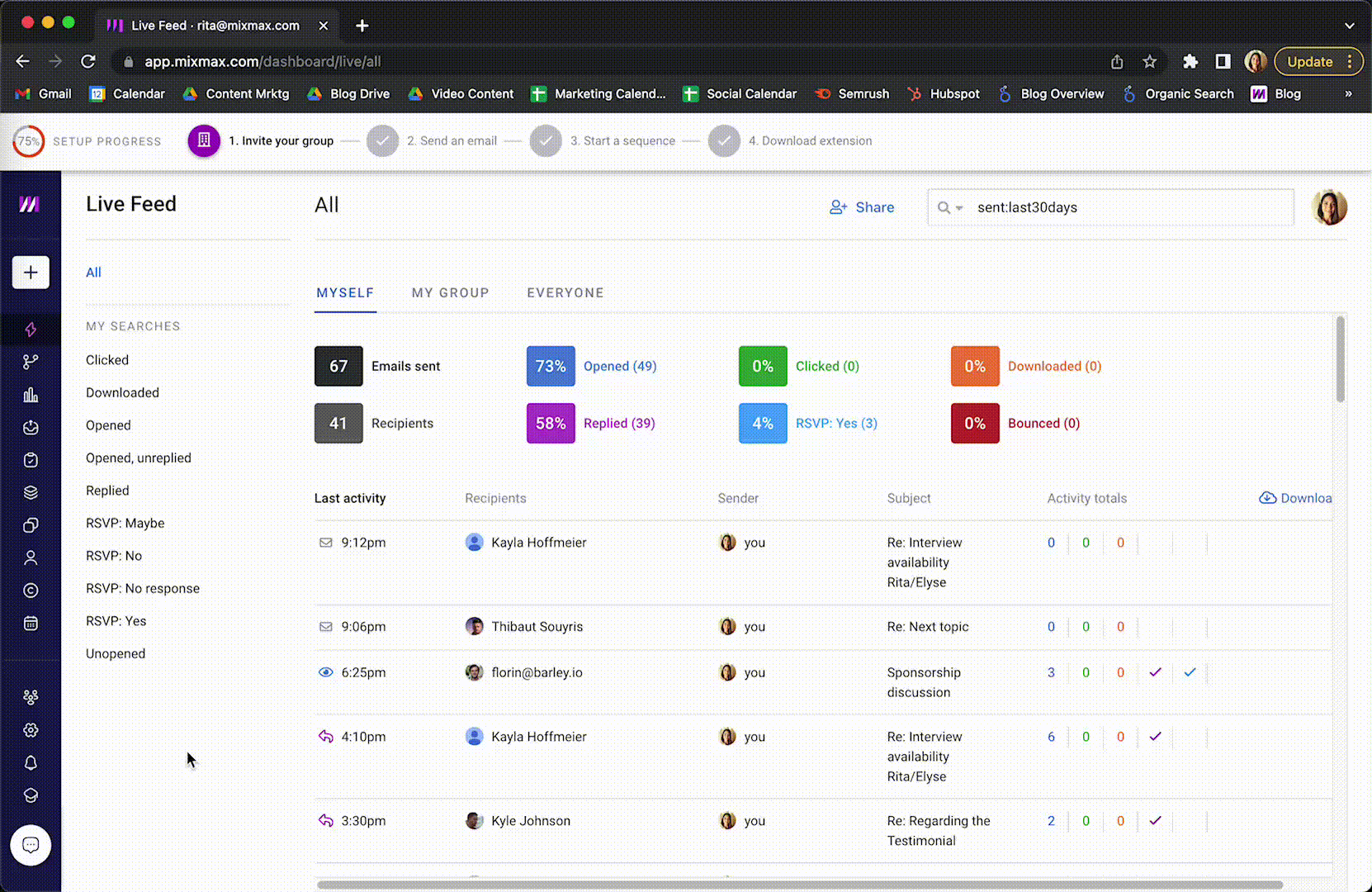Not every salesperson has the luxury of outbounding to a small mailing list. Or the luxury of being able to do hours of research to personalize each individual message.
If you’re part of a sales team that outbounds to hundreds or thousands of prospects, you need a different strategy.
And no, that strategy isn’t spray and pray.
The answer lies in personalization at scale, meaning sending tailored, meaningful messages to many prospects without losing that personal touch.
Why bother?
Because generic outreach is as appealing as junk mail. In fact, it IS junk mail.
But beware, personalization done wrong is just as bad as not doing it at all. You cannot simply insert the prospect’s name in the subject line and call it a day. You must understand your prospect’s challenges, avoid creepy familiarity (we’ll explain later), and never rely solely on automation.
We ran a webinar with sales legends Jen Allen-Knuth, Jason Bay, and Mixmax’s SDR Manager Jack Wauson on how to achieve personalization at scale (click the image below to access the recording ⬇️)
In this blog post, we break down everything discussed during that webinar and more.
What is personalization at scale?
Personalization at scale refers to the ability to deliver tailored, individualized messages and experiences to a large number of prospects or customers without compromising on quality or relevance.
It's about striking a balance between personalization and efficiency, enabling sales teams to connect with prospects in a meaningful way, even when dealing with high volumes.
The impact of generic outreach
Generic sales tactics are about as welcome as spammy flyers stuffed in your mailbox—quickly discarded and forgotten. Here’s a breakdown of why they fail to resonate:
- Avoidance behavior: Jen Allen-Knuth likens generic outreach to mall kiosk vendors that shoppers instinctively avoid. Consumers dismiss impersonal sales pitches that interrupt their day.
- Old tactics don’t work: Jason Bay points out that what used to be novel, like adding a name to an email or subject line, is no longer engaging (and is not considered real personalization).
- Uninteresting content: Jack Wauson compares sales emails to movie trailers, suggesting they should entice the viewer. If the trailer—i.e., the email—doesn't captivate, it's unlikely to encourage further engagement.
How NOT to personalize your outreach
Personalization in sales outreach is critical, but doing it wrong can be just as bad as not doing it at all. Here are some key pitfalls to avoid, based on insights shared during the webinar:
Using only basic personalization
Avoid superficial touches. Simply inserting the recipient’s name or company into an email doesn’t cut it anymore. As Jason highlighted, these once-novel tactics are now expected and do little to impress or engage.
Overlooking relevant context
Don’t ignore the details. Jen pointed out that effective personalization involves more than acknowledging a prospect’s job title or industry. It requires understanding and integrating their current business challenges and opportunities into your message.
Missing the context can lead to messages that feel out of touch and irrelevant.
Making assumptions without research
Base your outreach on solid data. Jack discussed the importance of using accurate, up-to-date information about the prospect’s business environment.
Making assumptions without research can lead to inaccuracies that turn off potential clients. He explained, "A lot of people just don't know what to look for to personalize... You just may not be looking in the right spots," underscoring the necessity of thorough research.
Using creepy or overly familiar language
Keep it professional and respectful. A common mistake in personalization is crossing the line from friendly to creepy or overly familiar.
One webinar participant shared an example of receiving an email that commented on the weather in their city and made an inappropriate comparison to a public figure, which was both irrelevant and off-putting. Such attempts at personalization can feel invasive and are likely to damage rapport rather than build it.
Relying solely on automation
Blend technology with a human touch. While automation tools are invaluable for managing large volumes of outreach, relying solely on them can lead to generic and impersonal communications.
As discussed in the webinar, reviewing and customizing automated content is crucial to ensure it aligns with each prospect's specific needs and interests.
How to segment your prospect list to achieve personalization at scale
Segmenting your prospect list effectively is essential for crafting targeted and meaningful sales outreach. Here's how the sales experts from the webinar suggest tackling this crucial task:
Industry and persona
Start by segmenting your list by industry and persona. This basic categorization helps tailor your messages to address the specific challenges and interests of each group. For instance, the needs of a startup might differ vastly from those of an established corporation, just as the needs of an SDR vary from those of an AE.
Triggers and signals
Jason suggests looking for specific triggers or business signals that indicate a timely opportunity for outreach. This could include funding announcements, product launches, or significant changes in leadership. Understanding these triggers can help you connect your solution to current events in your prospect's world.
Personalization trigger examples by Jason Bay from Outbound Squad
Geographic segmentation
If your product or service has regional relevance, segmenting by location can be highly effective. Jason notes, "If you thought of your target list, and everyone you're reaching out to, like a marketing list, you are getting to decide what ads you want to put in front of them."
Technographic data
Segmenting by the tech your prospects use can also provide insights into their operations and potential pain points. This approach is useful for B2B tech providers.
Engagement levels
Tracking how prospects interact with your content and outreach efforts can help you further segment your list based on engagement levels. This allows you to prioritize leads who have shown a higher level of interest.
Fun fact: Mixmax’s sales engagement platform has built-in engagement scoring features so you can filter by the most engaged prospects and send personalized and targeted messaging to those folks.
Buying stage
Understanding where each prospect is in the buying process (awareness, consideration, decision) can help you deliver the most relevant content at the right time to move them through the sales funnel.
Common challenges
Jen discusses how segmentation can also be based on common challenges within an industry or role. For example, if a segment of your market is shifting from physical products to services, you can tailor your outreach to address the specific challenges of selling intangible products.
Advanced prospect research tools for personalization at scale
Advanced prospect research is key to understanding and effectively engaging with your potential clients. During the webinar, the experts shared a wealth of insights on how to utilize specific tools and techniques to deepen your research and refine your sales strategies. Here’s a comprehensive look at the methods discussed:
LinkedIn Sales Navigator Boolean Search
- Precision Targeting: LinkedIn Sales Navigator allows for complex Boolean searches that help you filter and find prospects based on very specific criteria such as job titles, company size, and more. For example, using Boolean operators like AND, OR, and NOT can refine your searches to exclude or include precise attributes, helping you target the right individuals.
- Engagement Tracking: This tool also enables sales teams to monitor the engagement levels of prospects with your content, allowing for dynamic adjustments to your outreach strategies based on real-time interest and interactions.
Seeking Alpha for financial insights
- Deep dive into Company Health: Seeking Alpha is an invaluable resource when researching publicly traded companies. It offers detailed financial reports, earnings call transcripts, and expert analysis that can provide deeper insights into a company’s financial health and strategic direction.
- Trigger events: For example, if a company announces major strategic changes during an earnings call, this could serve as a trigger event for personalized outreach, suggesting your solutions or services that align with their new direction.
Google searches and public interviews
- CEO insights: Searching for interviews or podcasts featuring company leaders can reveal strategic insights and personal priorities that aren’t captured in official reports. This approach was highlighted by Jen who mentioned using Google to find interviews, which often provides a more candid view of a leader’s vision and challenges.
Technographic data
- Tech stack analysis: Understanding what technology a prospective company uses can provide clues about their needs and potential pain points. For instance, a company using an older CRM system might be a prime candidate for an upgrade pitch from a newer, more dynamic CRM provider.
Job postings and hiring data
- Growth and expansion indicators: Analyzing a company’s job postings can indicate areas of growth or strategic emphasis. For example, an increase in IT hires might suggest upcoming tech initiatives or a digital transformation drive.
How to personalize at scale using sales sequences
If you’re outbounding to a large list (which is the case for most salespeople), it’s impossible to personalize every single email you send out.
But, as mentioned in this post, personalization at scale is all about proper segmentation and non-time-consuming research.
As in, not more than 5 mins per recipient.
And once you have that tidbit about a prospect, you need a way to include it in your sequences without disrupting the whole flow.
Mixmax Sequences allows you to personalize emails within a sequence BY RECIPIENT.
So you can just go in and customize the opening line or the P.S. section for a recipient without editing the entire sequence for everyone on the list.
Here’s what that looks like ⬇️

4 examples of personalized cold emails
It’s all good and well talking about what personalized sales emails should look like in theory. But what do they look like in practice?
Here are a few frameworks and real-life examples we put together for inspiration.
Note: Do NOT copy and paste any of these. These are meant to guide you; you need to do your own research and segmentation to personalize your outreach.
1. Personalized (mobile-friendly) cold email example
Here’s a LinkedIn post Jason Bay published on cold email personalization and mobile optimization:
2. Hyper-personalized BEFORE/AFTER of a real cold email our marketing team received
Here’s a cold email our marketing team received and below is how Jason Bay revamped it with personalization.

BEFORE ⬆️

✨ AFTER ✨ (crafted by Jason Bay) ⬆️
3. Personalized BEFORE/AFTER cold email with poll feature
Here’s a before and after of a cold email our marketing team received and that we embellished. It also includes a nifty feature that lets you include polls in an email to boost replies.
4. Personalization based on a 4-min Google & LinkedIn search
(This example is courtesy of Jen Allen-Knuth. She wrote it within 4 minutes (live) DURING the webinar⬇️).
|
Hi Rita, I noticed Mixmax recently launched a HubSpot integration, which is a big step! Not sure if this is part of a bigger strategy to move upmarket and win more logos… But if I’m on the right track, have you considered bringing case studies like the one from Gong to life in a video format? One of our clients did this without adding headcount and saw a significant increase in engagement. Either way, what you're doing is awesome. Btw, I saw on LinkedIn that your daughter’s favorite word is "no" – mine too 😅 [Name] |
That’s a wrap
Mastering personalization at scale can transform your sales outreach from generic to genuinely engaging. Here's a quick recap of the key points:
- Personalization at scale: Send tailored, meaningful messages to large groups without losing that personal touch.
- Why it matters: Generic outreach is ineffective and often ignored.
- Common pitfalls: Avoid superficial personalization, irrelevant context, making assumptions without research, creepy familiarity, and over-reliance on automation.
- Effective techniques: Blend technology with human insights, segment your prospect list, and use advanced research tools.
By embracing these strategies, you can ensure your sales messages resonate and build meaningful connections with your prospects.
Frequently Asked Questions (FAQ)
How do I measure the success of personalized outreach?
Track metrics such as open rates, reply rates, and engagement levels. These metrics can easily be tracked through Mixmax’s analytics dashboards.
Can personalization at scale be automated?
Yes, but it's crucial to review and customize automated messages to ensure they feel personal and relevant to each prospect or segment.
What tools can help with personalization at scale?
Tools like Mixmax for personalized email sequencing, LinkedIn Sales Navigator for prospect research, and CRM systems that integrate with your other sales tech stack can significantly aid in effective personalization.






